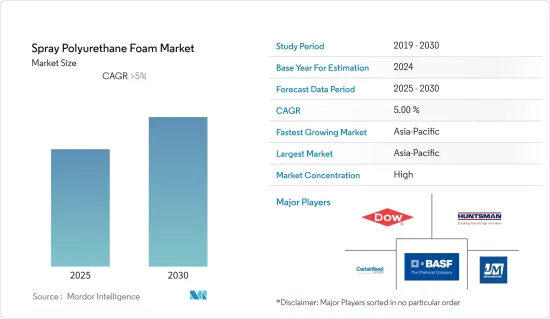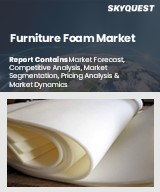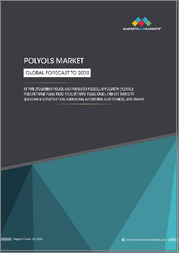
|
시장보고서
상품코드
1630194
스프레이 폴리우레탄 폼 시장 : 시장 점유율 분석, 산업 동향 및 통계, 성장 예측(2025-2030년)Spray Polyurethane Foam - Market Share Analysis, Industry Trends & Statistics, Growth Forecasts (2025 - 2030) |
||||||
■ 보고서에 따라 최신 정보로 업데이트하여 보내드립니다. 배송일정은 문의해 주시기 바랍니다.
스프레이 폴리우레탄 폼 시장은 예측 기간 동안 5% 이상의 CAGR이 예상됩니다.

주요 하이라이트
- COVID-19는 공급망과 원재료의 혼란을 일으키고 자동차와 건설과 같은 산업의 감속으로 이어졌기 때문에 스프레이 폴리우레탄 폼의 생산이 감소했습니다. 스프레이 폴리우레탄 시장은 예측 기간 종료시(2021년)에는 팬데믹 전의 수준에 이를 것으로 예상됩니다. 이것은 경기가 좋아지기 시작하고 공급 상황이 좋아졌기 때문입니다.
- 온실가스 배출에 대한 우려 증가와 건물 내구성 관리 전략의 주요 부분으로서 시장의 큰 잠재력은 단기적으로 시장 성장을 이끌어내는 주요 요인입니다.
- 한편, 유리 섬유나 셀룰로오스의 단열 제품이 보급되고 있어, 이것이 시장의 성장을 둔화시킬 가능성이 높습니다.
- 향후 몇 년간은 콘크리트 부피 상승 사업에서 폼 리프팅이 보급되고 있기 때문에 시장이 벌 수 있는 기회는 늘어날 것으로 보입니다.
- 스프레이 폴리우레탄 폼(SPF) 재료의 소비에서 아시아태평양은 큰 점유율을 차지합니다. 이 지역은 또한 에너지 효율적인 건설과 석면 봉쇄 적용 증가로 예측 기간 동안 가장 빠른 성장을 나타낼 것으로 기대됩니다.
스프레이 폴리우레탄 폼 시장 동향
단열 용도에서의 사용 증가
- 스프레이 폴리우레탄 폼은 단열재 적용에 사용되며, 소비는 시간이 지남에 따라 꾸준히 증가하고 있습니다. 그러나 스프레이 폴리우레탄 폼 단열재는 지난 10년간 급격한 성장을 이루었습니다.
- Energy Saving Trust의 계산에 따르면 주택의 열 손실의 25%는 지붕에서 35%는 벽에서 25%는 창과 틈새 바람에서 15%는 바닥에서입니다. 따라서 공동의 벽과 로프트 또는 지붕의 단열은 모두가 설치할 수 있는 가장 효과적인 에너지 효율화 대책의 두 가지입니다.
- 벽, 천장, 바닥, 다락방, 천장 뒷면, 다락방, 지붕 등 건물 외벽에 스프레이 폴리 우레탄 폼이 널리 사용되는 것은 에너지 효율 향상, 특히 건물의 공기 누출을 줄이기위한 법규에 직접 관련이 있습니다.
- 아시아태평양에서는 주요 경제권 인구 증가와 급속한 도시화로 주택 건설 수요가 증가하고 있습니다. Global Construction Perspectives와 옥스포드 이코노믹스의 조사에 따르면, 인도에서는 향후 14년간 주택 수요 증가에 대응하기 위해 매일 3만 1,000호의 주택을 건설할 필요가 있습니다. 2030년 말까지는 1억 7,000만 호의 주택이 건설될 전망입니다.
- 캘리포니아 주 Title 24와 국제 기준 심의회의 International Energy Conservation Code와 같이 점점 더 엄격해지는 건축 기준법을 통해 건설 업체는 화석 연료 사용량이 적고 에너지를 절약할 수 있는 재료를 사용해야 합니다.
- 게다가 하버드대학 주택연구 공동센터에 따르면, 미국인만 해도 주택의 개축이나 수선에 연간 4,000억 달러 이상을 지출하고 있으며, 그 중에는 단열재의 사용도 포함되어 있을 가능성이 있으며, 그 결과 수요가 증가하고 있습니다.
- Eurostat가 발표한 데이터에 따르면 2021년 건축 수입은 크게 증가했습니다.
- 이러한 점에서 단열재에 SPF를 사용하면 향후 수년간 스프레이 폴리우레탄 폼 시장이 확대될 가능성이 높습니다.
시장을 독점하는 아시아태평양
- 아시아태평양이 예측 기간 동안 가장 큰 시장이 될 것으로 예상되는 이유는 정부가 이 지역의 건설 및 코팅 산업에 더 많은 지출을 하고 있기 때문입니다.
- 중국은 아시아태평양에서 GDP가 가장 큰 경제 강국입니다. 이 나라의 성장률은 여전히 높지만 점차 낮아지고 있으며 경제는 투자에서 소비로, 제조업에서 서비스업으로, 외수에서 내수로 재조정되고 있습니다.
- 중국의 14차 5개년 계획에 따르면 도시 지역의 정주자 수는 2025년까지 65%까지 증가하게 됩니다. 이에 따라 향후 수년간 조사 대상 시장에 대한 수요가 높아질 것으로 예상됩니다.
- 중국이 팬데믹에서 회복됨에 따라 많은 주택 건설 프로젝트가 시작되었습니다. 홍콩의 주택 당국은 2030년까지 10년간 30만 1,000호의 공공 주택을 공급하는 것을 목표로 하고 있습니다.
- 'Atma Nirbhar Bharat' 및 'Make in India'와 같은 이니셔티브는 자동차 산업을 밀어올릴 것으로 예상되므로 앞으로 몇 년동안 스프레이 폴리우레탄 폼 수요에 긍정적인 영향을 미칠 것으로 보입니다.
- NAP 2021 하에 말레이시아 자동차 제조업은 2030년까지 연간 147만대의 자동차를 생산할 것으로 예상됩니다. 현재부터 2030년까지 일본의 자동차 제조에 사용되는 스프레이 폴리우레탄 폼 수요가 증가할 것으로 예상됩니다.
- 위와 같은 요인들로 인해 예측 기간 동안 아시아태평양이 스프레이 폴리우레탄 폼 시장을 독점할 것으로 예상됩니다.
기타 혜택 :
- 엑셀 형식 시장 예측(ME) 시트
- 3개월간의 애널리스트 서포트
목차
제1장 서론
- 조사의 전제조건
- 조사 범위
제2장 조사 방법
제3장 주요 요약
제4장 시장 역학
- 성장 촉진요인
- 온실가스 배출에 대한 우려 증가
- 건물의 내구성 관리 전략의 주요 구성 요소로서의 강한 가능성
- 냉장 공간, 워크인 냉장고, 파이프, 탱크 등의 산업용 단열재에서 중요성 증가
- 억제요인
- 유리 섬유나 셀룰로오스 단열 솔루션과의 경쟁 격화
- 엄격한 환경보호청(EPA)과 노동안전보건국(OSHA)의 규제
- 업계 밸류체인 분석
- Porter's Five Forces 분석
- 공급기업의 협상력
- 소비자의 협상력
- 신규 참가업체의 위협
- 대체품의 위협
- 경쟁도
제5장 시장 세분화(금액 베이스 시장 규모)
- 제품 유형별
- 2액형 고압 스프레이 폼
- 2액형 저압 스프레이 폼
- 1액형 폼(OCF)
- 기타 제품 유형
- 용도별
- 단열
- 방수
- 석면 밀봉
- 실란트
- 기타 용도
- 지역별
- 아시아태평양
- 중국
- 인도
- 일본
- 한국
- 기타 아시아태평양
- 북미
- 미국
- 캐나다
- 멕시코
- 유럽
- 독일
- 영국
- 이탈리아
- 프랑스
- 기타 유럽
- 남미
- 브라질
- 아르헨티나
- 기타 남미
- 중동 및 아프리카
- 사우디아라비아
- 남아프리카
- 기타 중동 및 아프리카
- 아시아태평양
제6장 경쟁 구도
- M&A, 합작사업, 제휴 및 협정
- 시장 점유율(%)** 및 랭킹 분석
- 주요 기업의 전략
- 기업 프로파일
- ACCELLA CORPORATION
- BASF SE
- CERTAINTEED
- Dow
- Huntsman International LLC
- Icynene-Lapolla
- INVISTA
- ISOTHANE LTD.
- Johns Manville
- NCFI Polyurethanes
- SOPREMA
- Specialty Products Inc.
제7장 시장 기회 및 향후 동향
- 파이프라인 엔지니어링의 새로운 업계 표준이 되는 용도의 출현
- 부피 콘크리트 업계에서 폼 리프팅의 동향 확대
The Spray Polyurethane Foam Market is expected to register a CAGR of greater than 5% during the forecast period.

Key Highlights
- COVID-19 caused disruption in the supply chain and raw materials, leading to a slowdown in industries like automotive and construction, owing to which the production of spray polyurethane foams decreased. The spray polyurethane market is expected to reach its pre-pandemic level by the end of the forecast period, which is 2021. This is because the economy started to get better and the supply situation got better.
- Growing concerns about greenhouse gas emissions and the market's strong potential as a key part of a building's durability management strategy are the main things that will drive the market's growth in the short term.
- On the other hand, fiberglass and cellulose insulation products are becoming more popular, which will likely slow the growth of the market.
- In the next few years, the market is likely to have more chances to make money because foam lifting is becoming more popular in the concrete raising business.
- Asia-Pacific holds a significant share in the consumption of spray polyurethane foam (SPF) materials. The region is also expected to witness the fastest growth during the forecast period, powered by the increase in energy-efficient construction and asbestos encapsulation applications.
Spray Polyurethane Foam Market Trends
Increasing Usage in the Insulation Applications
- Spray polyurethane foam has been used in insulation applications, and its consumption has steadily grown over time. However, spray polyurethane foam insulation has experienced exponential growth during the past decade.
- The Energy Saving Trust calculates that 25% of heat loss in homes is through the roof, 35% is through the walls, 25% is through windows or draughts, and 15% is through the floor. Hence, cavity walls and loft or roof insulation are two of the most effective energy efficiency measures anyone may install.
- The widespread use of spray polyurethane foam in building envelope assemblies, including walls, ceilings, floors, attics, crawl spaces, and roofing, is linked directly to code-mandated improvements in energy efficiency and, specifically, requirements for reducing building air leakage.
- Across the Asia-Pacific region, demand for residential construction has been rising owing to the growing population and rapid urbanization across major economies. According to a study done by Global Construction Perspectives and Oxford Economics, India will need to build 31,000 homes every day for the next 14 years to keep up with the growing demand for housing in the country. By the end of 2030, this will add up to 170 million homes.
- More and more strict building codes, like Title 24 in California and the International Energy Conservation Code from the International Code Council, force builders to use materials that use less fossil fuel and save energy.
- Furthermore, according to the Harvard Joint Center for Housing Studies, Americans alone spend more than USD 400 billion per year on residential renovations and repairs, which may include the use of insulation, which in turn increases their demand.
- The demand for building insulation is expected to rise in Germany as residential construction expands.As per data published by Eurostat, building construction revenue increased significantly in 2021.
- Because of all of these things, the use of SPF for insulation is likely to grow the market for spray polyurethane foam over the next few years.
Asia-Pacific Region to Dominate the Market
- Asia-Pacific is expected to be the largest market during the forecast period because the government is spending more on the construction and coating industries there.
- China is the largest economy in the Asia-Pacific region in terms of GDP. The growth rate in the country remains high but is gradually diminishing, and the economy is rebalancing from investment to consumption, manufacturing to services, and external to internal demand.
- According to China's 14th five-year plan, the number of permanent urban residents is supposed to rise to 65% by 2025. This is expected to increase demand for the market studied in the years to come.
- As China recovered from the pandemic, many residential construction projects kicked off in the country. Hong Kong's housing authorities launched a number of initiatives to jumpstart the construction of low-cost housing.The officials aim to provide 301,000 public housing units in 10 years, until 2030.
- Government reforms aided significant growth in industrial production as well as end-user demand for automobiles in India.Initiatives, such as "Atma Nirbhar Bharat" and "Make in India," are expected to boost the automotive industry, thereby positively impacting the demand for spray polyurethane foams in the coming years.
- Under the NAP 2021, the automotive manufacturing industry in Malaysia is expected to produce 1.47 million vehicles annually by 2030. From now until 2030, this is expected to increase the demand for spray polyurethane foam used to make cars in the country.
- Owing to all the aforementioned factors, the Asia-Pacific region is expected to dominate the spray polyurethane foam market during the forecast period.
Spray Polyurethane Foam Industry Overview
The spray polyurethane foam market is consolidated by nature. Some of the major players in the market include (in no particular order) BASF SE, Huntsman International LLC, Johns Manville, Dow, and CERTAINTED, among others.
Additional Benefits:
- The market estimate (ME) sheet in Excel format
- 3 months of analyst support
TABLE OF CONTENTS
1 INTRODUCTION
- 1.1 Study Assumptions
- 1.2 Scope of the Study
2 RESEARCH METHODOLOGY
3 EXECUTIVE SUMMARY
4 MARKET DYNAMICS
- 4.1 Drivers
- 4.1.1 Growing Concerns Related to Greenhouse Gas Emissions
- 4.1.2 Strong Potential as a Key Component of the Durability Management Strategy for a Building
- 4.1.3 Growing Significance in Industrial Insulation for Cold Storage Spaces, Walk-in Refrigerators, Pipes, Tanks, and Others
- 4.2 Restraints
- 4.2.1 Growing Competition from Fiberglass and Cellulose Insulation Solutions
- 4.2.2 Stringent Environmental Protection Agency (EPA) and Occupational Safety and Health Administration (OSHA) Regulations
- 4.3 Industry Value-Chain Analysis
- 4.4 Porter's Five Forces Analysis
- 4.4.1 Bargaining Power of Suppliers
- 4.4.2 Bargaining Power of Consumers
- 4.4.3 Threat of New Entrants
- 4.4.4 Threat of Substitute Products and Services
- 4.4.5 Degree of Competition
5 MARKET SEGMENTATION (Market Size in Value)
- 5.1 Product Type
- 5.1.1 Two-component High-Pressure Spray Foam
- 5.1.2 Two-component Low-Pressure Spray Foam
- 5.1.3 One Component Foam (OCF)
- 5.1.4 Other Product Types
- 5.2 Application
- 5.2.1 Insulation
- 5.2.2 Waterproofing
- 5.2.3 Asbestos Encapsulation
- 5.2.4 Sealant
- 5.2.5 Other Applications
- 5.3 Geography
- 5.3.1 Asia-Pacific
- 5.3.1.1 China
- 5.3.1.2 India
- 5.3.1.3 Japan
- 5.3.1.4 South Korea
- 5.3.1.5 Rest of Asia-Pacific
- 5.3.2 North America
- 5.3.2.1 United States
- 5.3.2.2 Canada
- 5.3.2.3 Mexico
- 5.3.3 Europe
- 5.3.3.1 Germany
- 5.3.3.2 United Kingdom
- 5.3.3.3 Italy
- 5.3.3.4 France
- 5.3.3.5 Rest of Europe
- 5.3.4 South America
- 5.3.4.1 Brazil
- 5.3.4.2 Argentina
- 5.3.4.3 Rest of South America
- 5.3.5 Middle-East and Africa
- 5.3.5.1 Saudi Arabia
- 5.3.5.2 South Africa
- 5.3.5.3 Rest of Middle-East and Africa
- 5.3.1 Asia-Pacific
6 COMPETITIVE LANDSCAPE
- 6.1 Mergers and Acquisitions, Joint Ventures, Collaborations, and Agreements
- 6.2 Market Share (%)**/ Ranking Analysis
- 6.3 Strategies Adopted by Leading Players
- 6.4 Company Profiles
- 6.4.1 ACCELLA CORPORATION
- 6.4.2 BASF SE
- 6.4.3 CERTAINTEED
- 6.4.4 Dow
- 6.4.5 Huntsman International LLC
- 6.4.6 Icynene-Lapolla
- 6.4.7 INVISTA
- 6.4.8 ISOTHANE LTD.
- 6.4.9 Johns Manville
- 6.4.10 NCFI Polyurethanes
- 6.4.11 SOPREMA
- 6.4.12 Specialty Products Inc.
7 MARKET OPPORTUNITIES AND FUTURE TRENDS
- 7.1 Emerging Applications as the New Industry Standard for Pipeline Engineering
- 7.2 Growing Trend of Foam Lifting in the Concrete Raising Industry
샘플 요청 목록



















